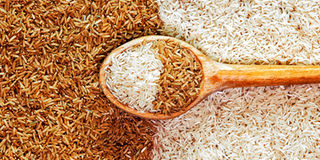Prime
Brown or white rice: Which is healthier?

Both brown and white rice are nutritionally rich and can be enjoyed as part of a balanced diet. Photo | xnutritionfacts.org
What you need to know:
- Rice, both brown and white is a rich source of several minerals and nutrients such as carbohydrate, protein, calories, fat, fibre, folate, vitamin B3 selenium, magnesium and manganese.
Although there are several types and varieties of rice, it is commonly categorised as long, medium and short grain, and brown or white rice. There are specific types of rice that come in both white and brown varieties, and black rice, which is a whole grain such as brown rice.
Rice, both brown and white is a rich source of several minerals and nutrients such as carbohydrate, protein, calories, fat, fibre, folate, vitamin B3 selenium, magnesium and manganese.
Differences
According to Ivan Philip Baguma, a dietician at Nella Organics, brown rice is a whole grain while white rice is the refined version of that same grain.
“A whole grain of rice consists of the bran, germ and the endosperm. White rice is created through a milling process in which the bran and germ are removed. During this process, many nutrients are lost. In some developed countries, white rice is typically enriched with vitamins and minerals that may have been lost in the milling process but not all, so there are usually nutritional gaps,” he says.
Brown rice tends to be nuttier and denser than white rice when it comes to taste and texture while white rice is often subtle and fluffy.
Brown rice is not brown by cooking but is simply whole rice that has not undergone the milling process. It retains its bran and germ, which are covering layers that contain high amounts of fibre and other nutrients such as vitamins, minerals, a small amount of protein and healthy fats.
“Therefore, if you have no access to brown rice, find a way of adding the fibre and protein to white rice by adding greens and vegetables which would help close the gap. Black beans or spinach would be good supplements,” Baguma adds.
The disadvantage with brown rice is that it usually requires more labour since the fibre-rich bran layer needs enough water penetration in order to create a softer texture like it is white rice. It takes longer to cook and can be a tougher consistency than white rice if not cooked for a long time.
Individual benefits
While both brown and white rice are great sources of carbohydrates, which is a preferred fuel source for the body and brain, they each have their own benefits.
Brown rice has a type of complex carbohydrate and is a whole grain. Daily intake of whole grains is said to reduce the risk of heart disease, diabetes and some cancers.
This type of rice also has a higher amount of fibre. One cup of brown rice for instance can provide about 11percent of the daily recommended value of fibre compared to white rice which offers only 2.1 percent of the recommended value of fibre.
“Brown rice also has a little more protein than white rice. Both fibre and protein keep one feeling satisfied for a long time and can help you maintain stable blood sugars and keep your weight in check,” Baguma says.
Brown rice is full of essential vitamins and minerals such as vitamin B3, magnesium, manganese and selenium, which are higher than those in white rice.
It has a lower glycemic index than white rice, which means blood sugar (or glucose) increases at a slower rate, making it a better option for people with diabetes.
The benefits of white rice
According to Baguma, white rice is economical and has a long shelf life (if dry) and can last up to two years if it is kept in an airtight container yet brown rice typically has a shelf life of six months.
If you suffer from stomach issues such as gastrointestinal distress, white rice is likely the better option for you since it is easy on the stomach compared to brown rice.
If you plan to exercise within a couple of hours of eating, white rice is ideal before the workout because it offers simple, easily digestible carbohydrates to energise you and help you move with ease.
The bottom line
Brown rice is more nutrient-dense than white rice. Because of this, brown rice may help reduce blood sugar levels and aid in weight management efforts. However, white rice is good for those with certain digestive issues who cannot digest fibre-rich foods well. Although brown rice has more nutrient value, both brown and white rice can fit well in a healthy, balanced diet in moderation.




